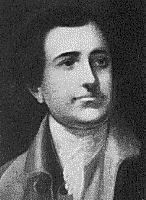A Biography of Edmund Randolph 1753-1813
 On August 10, 1753, Edmund Randolph was born in Tazewell Hall, Williamsburg, VA. His
parents were Ariana Jenings and John Randolph. Edmund attended the College of William and
Mary and continued his education by studying the law under his father's tutelage.
On August 10, 1753, Edmund Randolph was born in Tazewell Hall, Williamsburg, VA. His
parents were Ariana Jenings and John Randolph. Edmund attended the College of William and
Mary and continued his education by studying the law under his father's tutelage.
When the Revolution broke out, father and son followed different paths. John Randolph, a Loyalist, followed the royal governor, Lord Dunmore, to England, in 1775. Edmund then lived with his uncle Peyton Randolph, a prominent figure in Virginia politics. During the war Edmund served as an aide-de-camp to General Washington and also attended the convention that adopted Virginia's first state constitution in 1776. He was the convention's youngest member at age 23. Randolph married Elizabeth Nicholas in 1776.
Randolph continued to advance in the political world. He became mayor of Williamsburg and Virginia's attorney-general. In 1779 he was elected to the Continental Congress, and in November 1786 Randolph became Governor of Virginia. In 1786 he was a delegate to the Annapolis Convention.
Four days after the opening of the federal convention in Philadelphia, on May 29, 1787, Edmund Randolph presented the Virginia Plan for creating a new government. This plan proposed a strong central government composed of three branches, legislative, executive, and judicial, and enabled the legislative to veto state laws and use force against states that failed to fulfill their duties. After many debates and revisions, including striking the section permitting force against a state, the Virginia Plan became in large part the basis of the Constitution.
Though Randolph introduced the highly centralized Virginia Plan, he fluctuated between the Federalist and Antifederalist points of view. He sat on the Committee of Detail that prepared a draft of the Constitution, but by the time the document was adopted, Randolph declined to sign. He felt it was not sufficiently republican, and he was especially wary of creating a one-man executive. He preferred a three-man council since he regarded "a unity in the Executive" to be the "foetus of monarchy." In a Letter . . . on the Federal Constitution, dated October 10, 1787, Randolph explained at length his objections to the Constitution. The old Articles of Confederation were inadequate, he agreed, but the proposed new plan of union contained too many flaws. Randolph was a strong advocate of the process of amendment. He feared that if the Constitution were submitted for ratification without leaving the states the opportunity to amend it, the document might be rejected and thus close off any hope of another plan of union. However, he hoped that amendments would be permitted and second convention called to incorporate the changes.
By the time of the Virginia convention for ratification, Randolph supported the Constitution and worked to win his state's approval of it. He stated his reason for his switch: "The accession of eight states reduced our deliberations to the single question of Union or no Union."
Under President Washington, Edmund Randolph became Attorney General of the United States. After Thomas Jefferson resigned as Secretary of State, Randolph assumed that post for the years 1794-95. During the Jefferson-Hamilton conflict he tried to remain unaligned. After retiring from politics in 1795, Randolph resumed his law practice and was regarded as a leading figure in the legal community. During his retirement he wrote a history of Virginia. When Aaron Burr went on trial for treason in 1807, Edmund Randolph acted as his senior counsel. In 1813, at age 60 and suffering from paralysis, Randolph died while visiting Nathaniel Burwell at Carter Hall. His body is buried in the graveyard of the nearby chapel.
